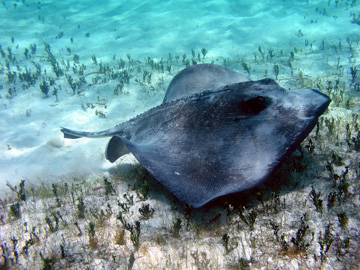Watch a stingray glide over the sandy sea floor and you can tell it’s in hunting mode — but the tricks the ray is using to search for prey may not be so obvious.
A stingray’s eyes are located on top of its wide, flat body, while its mouth is on the underside. This may not seem like the best design for a fish that has to scan the murky bottom for hidden clams and crustaceans. Luckily, rays are endowed with remarkable sensory abilities that make them ace hunters.
 A Southern stingray moves along the sandy bottom in the U.S. Virgin Islands. Credit: National Oceanic and Atmospheric Administration
A Southern stingray moves along the sandy bottom in the U.S. Virgin Islands. Credit: National Oceanic and Atmospheric AdministrationOne of these senses is the lateral line system, a “sixth sense” that all other fishes also have. Arranged in lines along the ray’s body are canals containing sensory organs that detect the movement of water. These canals run on the top and underside of the ray’s body, around its mouth and out to the edges of its wing-like flaps.
Small bottom-dwelling organisms, such as clams, produce small jets of water when breathing and feeding. When rays get in close range, these miniscule water movements tip off the lateral line system, allowing the hunter to zero in on a potential meal.
As if this weren’t enough, rays have another secret weapon: an electrosensory system. Along with their relatives, the sharks, rays possess a network of visible pores on their undersides that open to structures called the ampullae of Lorenzini. The ampullae pick up on tiny electrical impulses produced by the muscle contractions of bivalves, crustaceans, and even fishes buried in the sand. When a ray’s on the hunt, there truly is nowhere to hide!


